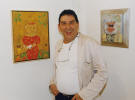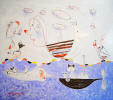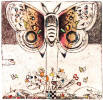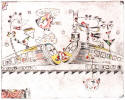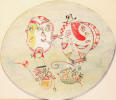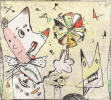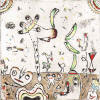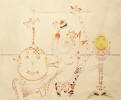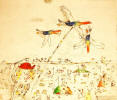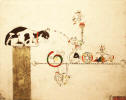JORGO KRALLIS, Artist
Please click on the photos to view them in bigger size.
Copyright art and photos © Jorgo Krallis
BIOGRAPHY (ENGLISH) / BIOGRAFI (SVENSKA)
BIOGRAPHY
Born at Thessaloniki, Greece, in 1937. Graduated from the Anatolia American College. Studied theatre, stage design and cinematography in Munich, at the Max Reinhart Theatre. Also, attended an Art Academy and studied art and engraving. Continued art studies for another year in Paris, followed by four years of creative design in Amsterdam. From 1966 to 1971 was enrolled in the Graphic Arts (engraving) Department of the School of Fine Arts at the University of Stockholm. Has been residing and working in Sweden since 1966.
PERSONAL EXHIBITIONS
1961 Gallerie D'Eendt, Amsterdam
1963 Anatolia Art Studio, Thessaloniki
1965 Hilton Gallery, Athens - Gallery 55, New York
1966 Pan American, Dallas (Texas)
1967 A H Grafik, Stockholm- Galleri Güggenbuhl, Vern
1968 Gröna Paletten, Stockholm
1970 Galleri Belle, Västerås
1972 Galleria Insicione, Milan - Galleri Hedenius, Stockholm
1973 Konstfrämjandet, Stockholm, Malmö
1974 Gröna Paletten, Stockholm - Galleri Belle, Västerås
1975 A H Grafik, Stockholm - Galleri Mett, Umea - Galleri Unicorn, Copenhagen, Grafiska Sällskapet, Stockholm
1976 Borås Konstgalleri - Galleri Zouboulaki, Athens - Galleri AE, Goteborg
1977 Göteborgs Konstmuseum, Göteborg - Grafoteket, Stockholm
1978 Galleri I, Goteborg - Anchel Gallery, London - LP Gallerie, Düsseldorf
1979 A H Grafik, Stockholm, Art Expo, New York
1980 Galleri Bragge, Malmö
1981 Galleri I, Göteborg - Gallerie Du Nord, Borås
1982 Bromton Gallery, London, Konstfrämjandet, Stockholm
1983 Galleri La Hune, Paris - Grafiska sallscapet, Stockholm
1984 Galleri Fort, Barcelona - Musee D'Arte, Madrid
1985 Galleri Nord, Orebro - Konstnärshuset, Stockholm - Swedish Institute of Culture, Athens
1987 Galleri I, Goteborg - Galleri Skånes Konstförening, Malmo, - Galleri Du Nord, Borås1988 Galleri 54, Göteborg - Galleri Gripen, Karlstad
1989 Bibliothèque Nationale, Paris - Galleri Gamla Berget, Falun -Galleri Bergman, Stockholm - Konsthall Forum, Nacka
1990 Galleri Bergman, Karlstad -Galleri Nord, Orebro - Galleri Rackgården, Kalmar
1992 Galleri Du Nord, Borås - Galleri Mergman, Göteborg -Galleri Artis, Gävle
1993 Galleri Skånes Konstfrorening, Malmö
1994 Eskilstuna Konstfrorening, Eskilstuna Konstmuseum
1995 Engravers Association, Stockholm - Konstfrämjandet, Malmö - Gallery Titanium, Athens
1996 Galleri Lorensberg, Göteborg
1998 Galleri Bergman, Karlstad - Landskrona, Konsthall
1999 Retrospective Exhibition, Th. Makrides Hall, Municipal Gallery of Thessaloniki
MAIN GROUP EXHIBITIONS
1971 Five Engravers from Sweden, Milan, Rome, Bari, Capri, Genova
1972 Graphics Bienale, Fredrikstad, Norway
1973 Graphics Bienale, Ljubliana
1973 International Award of Engraving, Italy
1976 International Exhibition of Graphic Art, Frechen, Germany
1976 International Trienale of Colour Engraving, Grenchen, Switzerland
1978 Mediterranean Engraving, Leverkuzen, Germany - European Bienale of Engravings at Mulhouse, France
1981 The circus in our town, Liljevalchs Museum, Stockholm, Graphics Bienale at Sao Paolo, Argentina
1985 Graphics Festival, Liljevalchs Museum, Stockholm
1986 Graphics Trienale, Sweden
1986 Art Exhibition New York - Three Greek artists from Sweden, Svenska Institute, Athens
1987 Art Exhibition, Sweden - Tapestry Exhibition, IBM Centre, New York, Osaka, Montreal, Slockholm
1989 Europe of Engravers, Grenoble, France
1992 Spring salon, Liljevalchs Museum, Stockholm
1992 Art Center Gallery, Sydney, Australia
1998 Engravers of Europe, Le College Neerlandais, Paris
1998 CIRKUS House of Engraving, Mariefred, Sweden, ENIGMA, Landskrona Museum, Sweden
DECORATIONS - OUTDOOR SCULPTURES
1983 Decoration of 600 sq.m. ceiling at the Postal Centre of the city of Falköping (12 Mobile sculptures), Sweden
1985 Decoration of ceiling with Mobile, at the children's hospital of Karolinska, Stockholm, Sweden
1988 Decoration of ceiling with Mobile at the children's day care center in the city of Länesta, Sweden
1990 Mobile sculpture, height six meters, in the region of Eriksfält, in the city of Malmö, Sweden
1995 Tapestry for the New Hospital of Tokyo, Japan
1997 Decoration of ceiling with Mobile at the Popular Honse of the city Linköping, Sweden
His works are exhibited in many Museums, Galleries and private collections in Europe, the United States and Japan.
DISTINCTIONS - AWARDS
He has received honorable mention in the International Trienale of Engraving at Grenchen, Switzerland. In 1968, he was awarded first price at the Bienale of Miniature Engraving, at Cadaques. In 1976, the Arts Academy of Sweden bestowed upon him a distinction, along with a state grant.
FILMS
"320 Engravers" by Gunnel and kjell Swärd
"Three Decades of Swedish Graphic Art" etc.
"Cirkus Mundi"
"TV Happening", 1983
________________________________________________________________________________
ART IN THE TIME MACHINE - MESSAGES WITHOUT BOUNDARIES
"What I am really seeking is movement without motion, something like what we call the eloquence of silence. In my painting the forms are at once mobile and motionless...it is precisely their immobility that suggests the idea of motion"
Miró
For more than three decades Jiorgos Krallis has occupied a very special place in the art world of Sweden, the country where he has chosen to live and work since 1966. The adoption of the multi-voiced Thessalonian artist - painter, sculptor, engraver - by that northern land was not surprising. Right from the outset his work was distinguished for the originality, freshness and intelligence of application of ideas which, although nourished by the personal semiology of his birthplace, have been described by distinguished art theorists as "expressing an art that has no boundaries". (Bertil Andrén, Maja Nittymaki, Borás Tidning, Maas Dahlberg, Katarina Östholm)
Nor has this changed with the passage of time, for his ideas have consistently confirmed his inventive freedom in their realization. A perceptive observer as well as a romancer and expresser of easily intelligible impressions and memories, as attentive as he is perspicacious, Krallis was to produce works startling in their stylistic practice, replete with a world artfully staged to be wondrous, lightsome and fantastic, without depriving it of the impression that it could well exist.
With this as his point of departure and personal benchmark, he was to develop his idiomatic art in ingenious and inexhaustible variations, a compendium of all his experiences in which his scintillating spirit sought harmonies even in ideas antithetical to the whole.
Krallis was born on Plateia Aristotelous, in the historic center of Thessaloniki, and there; despite the hardships and miseries of the German occupation, he spent the years of his childhood and early youth, carrying out his own campaigns with nettles and stones against a rodent enemy. His journalist father, Nikos, was the agent for a German film company, and with him the boy early learnt the fascination of the cinema projector, the dynamic of rapid change, the shaping of image. The toy shop run by his mother in the busy Egnatia marketplace, on the other hand, provided him with an opportunity to learn at first hand about another magical world, a microcosm of elaborate designs and bright colors that were rendered even more impressive by their mechanical movements.
Shortly after the end of the German occupation the family moved to Athens, and Krallis completed the first years of his secondary education there, before returning to Thessaloniki to finish his schooling as a boarder at the American College.
Determined to pursue a career in the arts, he initially chose to study drama, stage design and cinema at the Max Reinhart School, and engraving at the Munich Art Academy. This was followed by one year of painting in Paris, and four years of creative design in Amsterdam, where he showed his work for the first time. He then postponed the next stage of his program for two years to return to Greece to do his military service, before completing his formal education (1966-1971) in the Graphic Arts department (engraving) of the Stockholm School of Fine Arts.
His military service brought him back to Thessaloniki, where he rented a room in an abandoned neoclassical mansion at the beginning of Vasilissis Olgas Street, opposite the seafront. The empty rooms in the house, the strange lodger in the next room who, as he later discovered once they had become fast friends, was an itinerant magician with a provincial circus, and the Fellini-esque (his description) family of an ancient bed-ridden crone with two unmarried daughters who lived on the ground floor in the company of an ever-growing army of cats, created a bizarre atmosphere that was also an inexhaustible source of contrasts, an atmosphere that created a powerful impression upon him and fired his imagination.
During this period (around 1963), cats featured in many of the works that he showed at the American College Club, as did, rats and mice. The intelligence and the cunning ruses displayed in their behavior during their midnight battles in the sad refuse tip of a garden behind the house inspired him to create images that, although light in subject matter, gave him the opportunity to transform with inventive elaboration the image of their reality into a mordant myth, a myth that functioned between the atmosphere of the mysterious and the wonder of life that exists everywhere, usually invisible to the large living machine of the adult world.
These were the motifs that were to predominate in his work, most notably in his engravings but also in his paintings, once he had taken up residence in Stockholm (1966). Enriched with other elements from his memories of the happy years of his childhood and youth, they were to become a powerful medium of expression, through which always ran a thread of nostalgia, the tender echo of a past that has become an inner reality. His works brought to life toys of every description, scenes from the circus, acrobats, clowns, illusions created out of the cheapest materials brightly colored cloth ribbons, balls, fur tails, the stuffed head of a hare with huge eyes - as he first saw them in the black trunk of his magician neighbor, insects and large animals - apes, camels, elephants, lions, giraffes. These series of engravings were to constitute the great group which he entitled "Circus Mundi", to which he devoted himself at that time and on which he continues to work to this day.
It is interesting to note that, before this decisive change of theme, Krallis had for 7 or 8 years followed the experimental spirit shared by most of his artist compatriots of the period. In a style alternately impressionist or abstract, he painted in oils and water colors maritime subjects (Fog, 1964), Greek island landscapes, rocks, flowers, thistles, even themes from mythology (Centaur, 1964). Often he gave a symbolic dimension to these compositions, creating works that functioned on the lines of personal surrealistic perception. Many of these found buyers in New York in 1965, during his exhibition at Gallery 55.
The changes that supervened with his installation in Sweden, organized under the light of his new visual reality, were - apart from his unique drawing skill - to appear clearly in his inventive and complex iconographic ability. These find their optimum application, as we have said, in his engravings. Lithographs and copper-plates, washed with water colors, become an arena of complex and finely drawn intermixtures, with protagonists drawn from the animal world, from toys in action, from - in a similar setting - figures of people who to the artist's eye resemble in character or in appearance some animal, bird or insect.
With this diverse and disparate tissue of types, through adroit changes of position and size, well-weighed with consummate skill and mathematical precision, everything appears to be at once motionless and moving, caught up in the whirl of an endless happy adventure. They radiate a sense that they could at any time change roles, suffused with sentiments of profound joy, their diabolical disposition to reverse their appointed destiny yielding with a start to the vision of a world with a new dynamic.
However, beneath this invention of a microcosm of such innocence, lightsome and seemingly weightless, so enchanting in its buoyancy that it is mistaken for reality in the shape of a strange dream, Krallis persuades us that he is not only an artist with an unusually enigmatic sense of humor but also an indefatigable practician of ambiguous metaphorical correlation. The easy access to his work yielded by his visual playfulness, however, is only superficial. Under closer observation, a very particular, complex and codified dialogue unfolds to intellectual exploration. And he provides the motives for this dialogue in his own unique fashion, inventing with the cunning of a small child pleasant allegorical scenes that lead the spectator into an exciting game of exploration in search of interpretations. From these we can see how in the hands of a conscious artist artist's materials can become tools that lead us from childlike wonder to everyday life in all its ordinariness, in the absurdity present everywhere whenever things threaten to go wrong, if the forces of equilibrium cease to be. And in Krallis stylistic argument with these essentially linked groups, it is difficult to define the boundaries between the "wonder" that he presents to us with every outward appearance of verisimilitude and reality. For in their description of worlds in "balanced chaos", in the phrase used by art critic Katarina Ostholm, these aggregate worlds with their rhythmic progression within their perspectives are worth a very attentive approach.
The subject matter of these works yielded, after 1982, three-dimensional constructions, his well-known mobiles. Some set on floor stands, mostly for outdoor settings, some designed to be hung from ceilings indoors, these works are an experiment conducted by Krallis in giving dimension to painted form, inserting them into space as plastic volumes. In their making he uses a variety of suitably chosen materials and intense luminous colors, with strong contrasts, or cool neutral shades. In creating them he seeks the sparest of design forms, giving particular importance to proportion in sizes and final result. He selects motifs viable in space, but at the same time functioning as exemplification of the elements of his visual art world.
In his multiple ceiling mobiles, and there are a considerable number of these, he finds the ideal way for them to function in space, each equiponderant but differing in energy in the setting and role in which it is called to participate. Thus the suspended sculpture is by definition autonomous, but is nonetheless dependent on the energy-charged whole, which stands out like the beginning of an order. So that they can be moved by external factors, he uses for the most part light metals, wood and Plexiglas.
For his outdoor sculptures, by contrast, he uses heavier, rustproof metals and enamel. He gives them monumental dimensions with a dynamic development in height and horizontal spread, finding clever solutions enabling them to act in space and on the collective public to whom they are addressed. In these works as in his mobiles the poetic frolicking with the proper dose of humor is only apparently exhaustible. Although they try to trap the eye with their inimitable grace, they engender the conviction that they conceal meanings beyond the image.
Krallis has to date won many tokens of recognition, among these a host of state commissions. Apart from sculptures of his that ornament interiors, parks and public squares, at least six of his designs for engravings have been used in tapestries for interior decoration, including, for example, the New Tokyo General Hospital. Krallis' response to the bidding of the art of this age continues with unsilenced conviction and insistence in his perceptions, complex and enigmatic in their conceptual and visual relations. As I followed his thoughts in an autobiographical confession, the words that have remained with me are those that speak of "the human circus of everyday life" and of "all that commotion [that] creates a scene, a magical image, whose purpose is humor, play, joy, courage for life!"
Elli Kaplani-Kokkini Art Historian
Thessaloniki Municipal Gallery
_______________________________________________________________
Född i Thessaloniki, Grekland, bosatt i Sverige sedan 1966.
Studier:
Konstakademien i München, Grafikskolan i Amsterdam, Konsthogskollans grafikskola i Stockholm.
Separatulställningar:
1961 Galerie d´Eendt, Amsterdam.
1963 Anatolia Art Studio. Thessaloniki.
1965 Hilton Gallery' Athens; Gallery 55, New York.
1966 Pan American, Dallas Texas.
1967 A H Grafik, Stockholm; Gallerie Guggenbuhl, Bern.
1968 Gröna Paletten, Stockholm.
1970 Galleri Belle, Västerås.
1972 Galleria Insicione, Milano; Galleri Hedenius, Stockholm.
1973 Konstfrämjandet Stockholm, Malmö.
1974 Gröna Paletten, Stockholm; Galleri Belle, Västerås.
1975 A H Grafik, Stockholm; Galleri Metz, Umeå; Galleri Unicom, Köpenhamn; Grafiska Sällskapet, Stockholm.
1976 Borås Konstgalleri; Gallery Zoumboulaki, Athen; Galleri A E, Göteborg.
1977 Göteborgs Konstmuseum, Göteborg; Grafoteket, Stockholm.
1978 Galleri I, Göteborg; Anchel Gallery, London; L P Gallerie, Düsseldorf.
1979 A H Grafik, Stockholm; Art Expo, New York.
1980 Galleri Bragge, Malmö.
1981 Galleri I, Göteborg; Gallerie du Nord, Borås.
1982 Bromton Gallery, London; Konstfrämjandet, Stockholm.
1983 Gallerie La Hune, Paris; Grafiska sällskapet, Stockholm.
1984 Gallerie Fort, Barcelona; Museo d´Arte, Madrid.
1986 Galleri Nord, Örebro; Konstnärshuset, Stockholm; Svenska kulturinstitutet, Athen.
1987 Galleri I, Göteborg; Galleri Skånes Konstforening, Malmö; Gallerie du Nord, Borås.
1988 Galleri 54, Göteborg; Galleri Gripen, Karlstad.
1989 Bibliotéque Nationale, Paris; Galleri Gamla Berget, Falun; Galleri Bergman, Stockholm; Konsthall Forum, Nacka.
1990 Galleri Bergman, Karlstad; Galleri Nord, Örebro; Galleri Rackargården, Kalmar.
1992 Galleri du Nord, Borås; Galleri Bergman, Göteborg; Galleri Artis, Gävle.
1993 Galleri Skånes Konstförening, Malmö.
1994 Eskilstuna Konstförening, Eskilstuna Konstmuseum.
1995 Grafiska Sällskapet, Stockholm, Gallery Titanium , Athen.
1996 Galleri Lorensberg,Göteborg.
1998 Grafikhuset, Mariefred.
1998 Landskrona Museum.
1999 Municipal art Museum of the city of Thessaloniki, Grekland.
Deltagit i flera samlingsutställningar i Sverige, Norge, Tyskland, Grekland, Italien, Schweiz, England, USA, Japan, Argentina m.fl. länder.
Erhållit pris vid Internationella Grafiktriennalen, Grenchen, Schweiz, 1968; 1:a pris vid Miniatur grafik biennal, Cadaques. Deltagit i flera grafikbiennaler såsom Ljubljana, Sao Paolo, Liljevalchs i Stockholm, Göteborg m.fl. städer. Tilldelats Konstakademiens stipendium och Statens stora arbetsstipendium 1976.
Offenilliga arbeten:
1983 Falköpings Postterminal, takutsmyckning (12 mobiler).
1985 Takutsmyckning för barnpolikliniken, Karolinska Sjukhuset, Stockholm; Textilutsmyckning, Statens Konstråd.
1990 Eriksfälts bostadsområde, Malmö, mobil skulptur, 6 m hög.
Film Och litteratur:
"320 grafiker" av Gunnel och Kjell Swärd; Tre decennier svensk grafik m.fl.; "Cirkus Mundi", TV-happening 1983.
Representerad:
Representerad i flera museer och samlingar i Europa, USA och Sverige (Moderna Museet, Stockholm; Modern Art Museum, New York; Musée d´Art Moderne, Paris; Bibliothèque Nationale, Paris; Brattford Museum of Modern Art, UK; Lunds Museum, Malmö Museum, Madrid Museum, Iolas Museum, Athen...)

